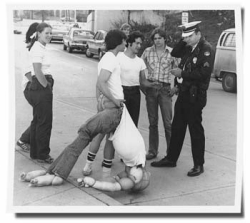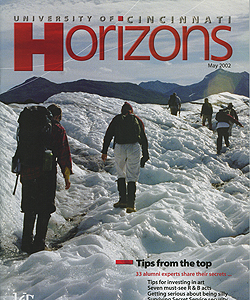Horizons magazine encourages readers to submit letters. Letters submitted online may be considered for publication here and in the print edition of the magazine.
Letters to the Editor

Investigation closed
I am filling in the blanks about the photograph of the officer standing with the students who had thrown a dummy off the top of Crosley Tower [On Campus Yesterday, June '01]. My name is Lt. Linda Qualters, and the police officer in question is my husband, John Qualters, who retired in April 2000.
I asked him about the photo, and he explained that he had received a call in reference to a professor who had almost been struck by the falling dummy. Upon his arrival, the professor was still obviously upset. I can only think that the professor's first thought was of a student prank.
Upon investigation, the students were found to be conducting an experiment. When the professor in charge of the students came out, the other professor decided he did not want anything done. Apparently, there were no arrests and no hard feelings between the two professors.
I thought that I would get this information to you prior to my own upcoming retirement.
Lt. Linda Qualters
3rd Shift Supervisor, UC Police
A sticky question
A number of famous UC alumni worked on developing the well-regarded burn ointment "Sperti," which came out of [alumnus] George Sperti's laboratory, including Joseph Kowalewski and Daniel Fuentes. Do any of your alumni know if and where Sperti ointment could be obtained today? Is it now marketed under a different name? Sperti was a veritable pharmaceutical institution in our family, but I'm unable to find it currently. Many thanks for your interest.
Edward Glenn
Via e-mail
Editor's note: George Sperti, Eng 23, also invented frozen orange-juice concentrate, Preparation H and sunlamps, but we have been unable to determine if his famous ointment is still available. Anyone have an answer?
Old advice still good
I have to confess that when I opened the [print edition] December medical issue of "Horizons," I concentrated on the beautiful photo spread of Albert [Sabin] with the Brazilian children [table of contents]. It was Christmas time, and it brought back so many memories of our many visits together to my native country.
Also, I was greatly gratified to read and reread your excellent article about the exhibit in the Vontz Center ["A Hero’s Story"]. It is not only a fitting tribute to Albert, but also a tribute to the tireless efforts of the UC director of the Cincinnati Medical Heritage Center Billie Broaddus.
Now I am able to answer your question that was posed on the postcard survey, "How much of this issue did you read?" "Most," I would answer. And I notice that John Bach, in his article "Catching up to Cancer," gave Cincinnatians the same advice that Albert, many times, gave to the Brazilians: "Stay home for medical care." Our docs are tops.
I also decided to click on NetWellness and want to congratulate you on your many awards.
Heloisa (Mrs. Albert) Sabin
Washington, D.C.
Outdated mail
We receive "Horizons" magazine and "Horizons News Update." We love 'em, but I guess we would appreciate receiving them at least in the same month as the issue date. For example, we received the October 2001 issue [of "Horizons News Update" newsletter] in November. It would be nice to read about upcoming events before they happen. We live in northern Ohio, so we are not far away.
Mr. and Mrs. John White III
Fremont, Ohio
Editor's note: We admit surprise and confess embarrassment. The newsletter was delivered to the post office in the first half of October, and some people did receive their copies before homecoming on Oct. 27, but we also know one reader didn't receive his until Nov. 17.
The point is: All the newsletters were printed and mailed at the same time, but much of the postal system had difficulty delivering nonprofit mail after anthrax incidents began.
We appreciate readers telling us about late mail, because it's our only way to determine how effective delivery is. One letter writer indicated our publications are "always late." We are unaware of any recurring problems, but ask you to notify us when publications are late, so we can tell you if the problem originated with us or the postal system.
In the past, we thought our timetables were practical. It appears we need to plan much further in advance. We apologize.
A little off key
I finally got around to reading the new issue of "Horizons Online" and enjoyed the article on Ted McCarty ["UC Alum Plugged in the Rock World ," December 2001]. I would see him at National Association of Music Merchants Shows, and after talking for a few minutes, he would remember me as the UC grad. Sharing that always made a nice way to break the ice.
I understand the need for glossing over the facts a little bit in articles, but I must take you to task on a couple points:
1) George Harrison was primarily identified for using Gretschs & Strats guitars as opposed to Les Pauls. He owned a few of 'em, of course, but wasn't singularly identified with them.
2) Jimmy Page played the solos to "Stairway" on a Telecaster & Fender Electric 12. He was definitely identified as a Les Paul user. I’ll split this one with you.
3) "Layla," one of the most identifiable licks in rock history was not played on a Gibson Guitar, much less a Les Paul. It was a Fender Stratocaster, a guitar which Eric Clapton has made his own for over 30 years.
The article was nice. I'm sure that the majority of people who knew McCarty as a result of Gibson Guitars never knew he was a Cincinnati native nor that he attended UC. I personally thought this was just too cool.
This is going on more than I intended to write. Although I didn't mean to pick on ya, I had to.
Danny Nader, CCM '86
Cincinnati
Via e-mail
Editor's note: It's too bad we didn't find Nader while doing our research. Finding original sources is difficult when writing an obituary, but we thought we had reputable ones: McCarty's hometown paper claimed Jimmy Page used a Les Paul on "Stairway," while the New York Times and The Guardian of London mentioned George Harrison, Eric Clapton and Page benefitting from McCarty's expertise. This reinforces a very basic rule from Journalism 101: "Check it out for yourself."
Absorbed in appearance
I am sure you get this same question constantly, but it seems like it never gets answered. UC is so absorbed in its appearance that the school wastes millions in the process. Why don't they just blow up the whole campus and start over fresh? Every time you turn around, you hear of another building that is scheduled to be torn down. Some are just barely 25 years old.
Much needed parking lots are being torn up for grass and dorms. I think the campus looks nice with the new green space, but has anyone thought about the consequences of more buildings and less parking? What is the purpose of having all of these nice buildings if you can't find a place to park in order to get to these buildings?
Denise Dunlap
Via e-mail
Editor's response: In a previous issue, we pointed out that the university lost only 20 parking places because it added garage space.
Where's the meat?
Thank you for asking alumni to respond to how they like "Horizons" [on the postcard survey]. Perhaps a bit arrogant on my part, I thought I would comment to a greater extent than the card allows. UC has always been important to me, and I take pride in being an "alum," yet I nonetheless have felt a certain ambivalence through the years, not least about the university's publications aimed at alumni.
First of all, the December issue of "Horizons" is indeed quite good -- certainly much better than many previous issues. Yet over all, it has generally been rather superficial in its content despite generally superb graphics.
I base that comment in comparing it to five other alumni magazines received in my household -- those of the College of Wooster, the Wharton School, Cornell University, the University of Michigan, and the University of Pennsylvania. Over all, these publications seem to have much "meatier" articles than does "Horizons," articles that appear more intellectually driven, focussing on the academic raisons d'etre of each institution.
I realize that perhaps the comparison is unfair. UC is a different institution from each of them; indeed, they all differ from one another. Yet, I do think that "Horizons" was a much better, more thoughtful publication when it was still "Cincinnati Alumnus" prior to the Bennis era. (I still have every issue of "Cincinnati Alumnus" and "Horizons" since September of 1961.)
Another point with which I take issue are the letters to the editor. So many of them -- if not most -- tend to be rather saccharine: "Oh, isn't U.C. nice, and doesn't it have a wonderful magazine, and, oh, I have such fond memories." When was the last time "Horizons" published a truly critical letter to the editor about an article or some other aspect of the University and its activities? I can't believe that you don't get some.
A final point of criticism is the periodic "Horizons Update," which is very superficial for a publication from a major academic institution -- homecoming, sports, Greek events. What about U.C.'s academic/intellectual endeavors? As I write, I am looking at Penn's quarterly newsletter to alumni with articles on astrophysics, bioethics, university traditions, an alumna working in the Arctic, faculty appointments, Sept. 11 -- and nothing about Penn having just won its league's Division I football championship.
One positive suggestion, in particular, I would like to make. How about a one- or two-page article in each issue entitled approximately "What Ever Became of ????," with some background on what a retired administrator or faculty member is doing now. For example, what about Hilmar Krueger, Taft Professor of history and founding dean of the University College -- now, I believe, in his 90s and living in Arizona?
Despite, apparently, having won a number of publication awards, "Horizons" could still be a much better magazine, one reflecting the real, transcendent significance of UC to American and, indeed, to world society. The December 2001 issue did just that, but will it continue to do so? I wonder.
Richard Sherman, A&S '61
Wayne, Penn.
Editor's note: Several points deserve a bit of explanation:
Content: Budget restrictions limit the magazine to 40 pages. For the sake of comparison, Cornell University usually publishes 112 pages; the University of Pennsylvania, 96; and the University of Michigan, 64. We find a broad focus necessary to cover UC's 17 different colleges, 500 programs, 33,000 students, 4,300 faculty and 206,000 living alumni within that size constraint.
Letters: We publish all letters that include the sender's name and address. Lucky for us, no letters were critical in the last issue. In the previous issue, however, two of the six letters were critical, complaining about unreadable type, incomplete information and the unwise construction of Sander Hall. The issue before that included grumblings about the Campus Green and omission of names among UC Living Legends. We print what we receive.
"Horizons Update": The newsletter's nameplate reflects its intended focus: "Horizons Alumni Association News Update."

 Past Issues
Past Issues